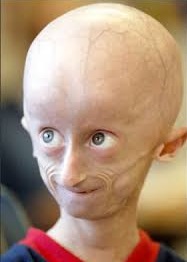Progeria Causes, Symptoms, Diagnosis and Treatment

What Is Progeria ?
Progeria, or Hutchinson-Gilford syndrome, is an extremely rare and progressive genetic disorder marked by rapid aging of children, a phenomenon which starts in the first two years of their lives.
Although such children may appear perfectly normal at birth, they may start to exhibit signs and symptoms during early on which may include slow growth and hair loss
Progeria proves to be fatal, not because of the condition itself, but primarily because of the complications it tends to cause. These may include heart problems or strokes.
While 13 years is the average life expectancy, People with Progeria can go on and live for 20 years or longer as well.
While there is no known cure for Progeria, research is still ongoing in this domain.
Causes Of Progeria:
As a result of the ongoing research, researchers have been able to find a gene mutation which they believe is responsible for Progeria.
The gene, known as Lamin A, is responsible for making a protein which is dubbed to be integral in holding the nucleus of the cell together. People who have the mutated gene have unstable cells which then lead to the aging process, which is a major characteristic of Progeria.
It is not inherited as none of the parents in the cases known had been carries. According to research, the genetic mutation tends to affect a single sperm or egg just before conception.
Symptoms Of Progeria:
The following signs and symptoms are exhibited:
- Narrowed face, small lower jaw, thin lips and beaked nose
- A large head which may be disproportionate to the rest of the body
- Slowed growth
- Prominent eyes and incomplete closure of the eyelids
- Hair loss, including eyelashes and eyebrows
- Thinning, spotty, wrinkled skin
- Visible veins
- High-pitched voice
- Hardening and tightening of skin on trunk
- Delayed and abnormal tooth formation
- Hearing loss
- Loss of fat under the skin and loss of muscle mass
- Fragile bones
- Stiff joints
- Hip dislocation
- Insulin resistance
- Severe progressive heart and blood vessel (cardiovascular) disease
- Visible Veins, which can be seen by the naked eye
Diagnosis Of Progeria:
Progeria can simply be diagnosed by observing the signs and symptoms during the physical examination. In order to confirm suspicion, a genetic testing may be performed
Treatment Of Progeria:
While there is no cure of Progeria, certain treatment may help in slowing down the process of aging:
- Low-dose aspirin, to prevent heart attacks and stroke.
- Physical and occupational therapy, to help with joint stiffness
- Extraction of primary teeth.
Related Articles:
Swimmers Itch Causes, Symptoms, Diagnosis and Treatment
Tularemia Causes, Symptoms, Diagnosis and treatment
Cold Sores Causes, Symptoms, Diagnosis and Treatment
Hemangioma Causes, Symptoms, Diagnosis and Treatment
Raynaud’s Disease Causes, Symptoms, Diagnosis and Treatment
Stye Causes, Symptoms, Diagnosis and Treatment
Antiphospholipid Syndrome (APS) Causes, Symptoms, Diagnosis And Treatment
Castleman Disease Causes, Symptoms, Diagnosis And Treatment
Diaper Rash Causes, Symptoms, Diagnosis and Treatment
Cellulitis Causes, Symptoms, Diagnosis and Treatment
Tinea Versicolor Causes, Symptoms, Diagnosis and Treatment
Prickly Heat Causes, Symptoms, Diagnosis and Treatment
By : Natural Health News




